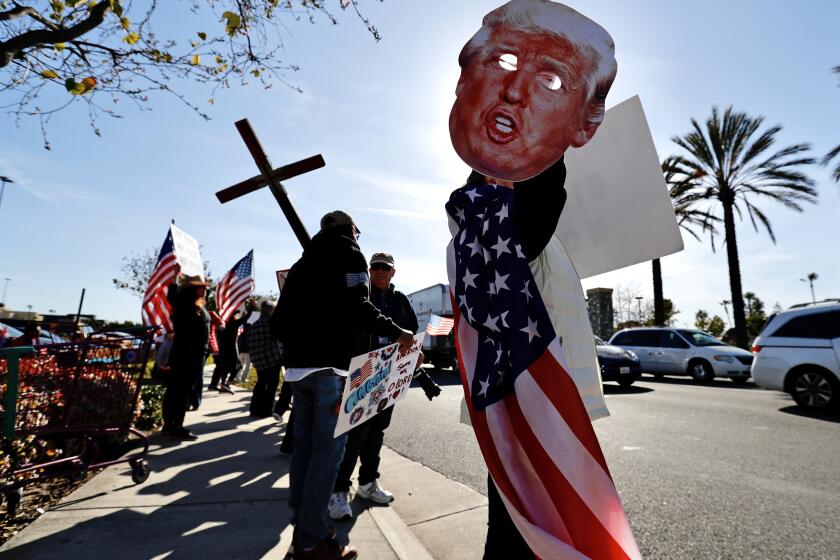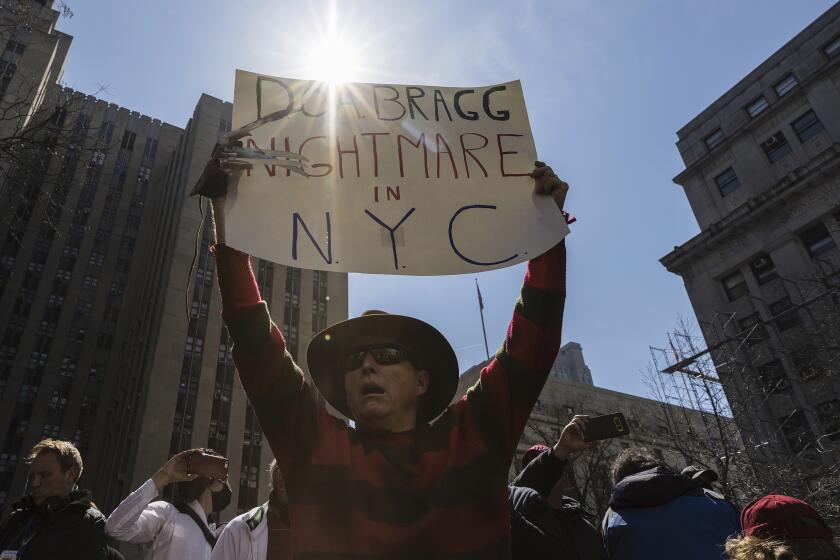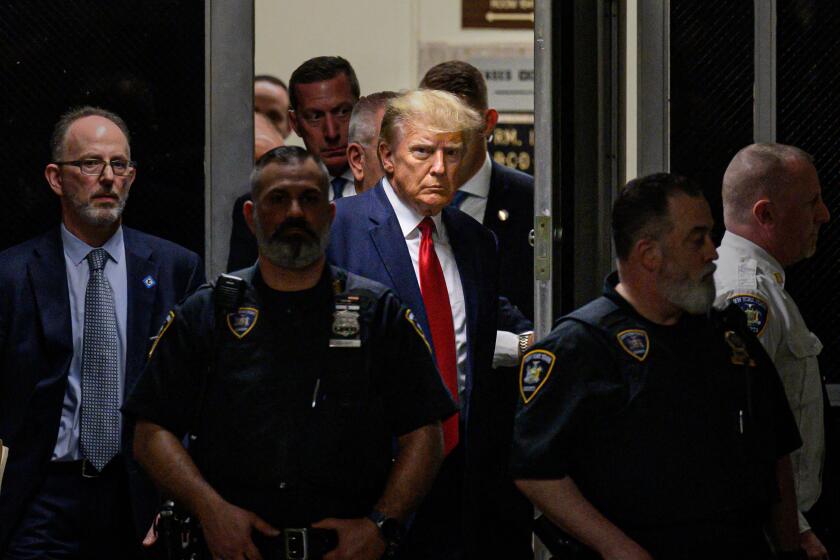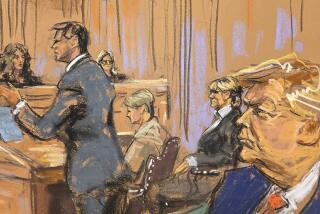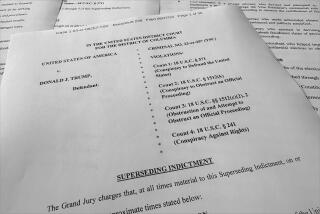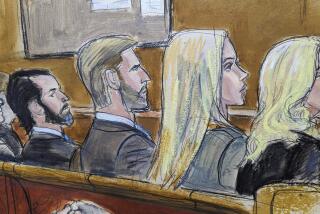Trump has been charged with 34 felony counts. How strong is the Manhattan D.A.’s case?
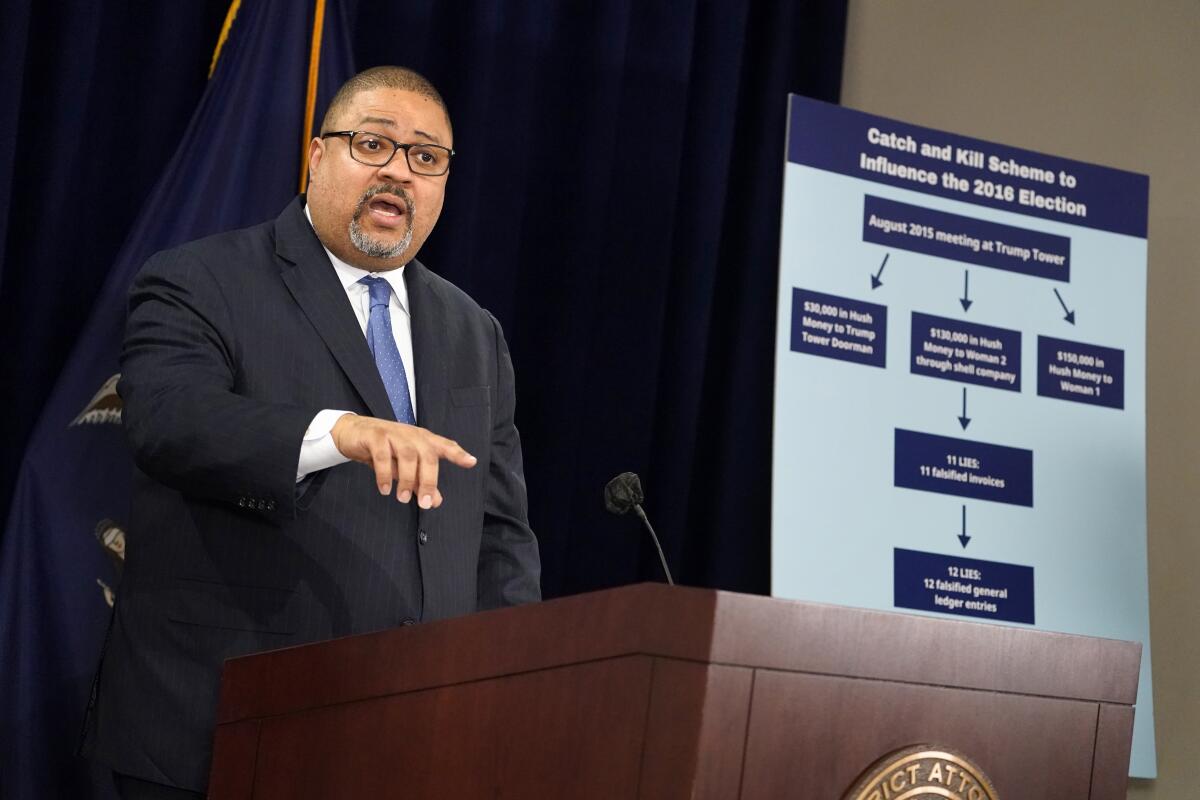
- Share via
In a 13-page court filing outlining the New York criminal case against former President Trump, Manhattan Dist. Atty. Alvin Bragg on Tuesday described a years-long “catch-and-kill scheme” in which Trump and his associates buried negative stories about him by doling out hundreds of thousands of dollars in hush money.
The payments in the run-up to the 2016 election — to a porn star, a Playboy model and a Trump Tower doorman — didn’t constitute crimes on their own, Bragg said. What did were Trump’s alleged efforts to cover up the scheme, including by falsifying company records to disguise the payments as legal fees, Bragg said.
The former president’s actions rose to the level of felonies, Bragg said in court documents, because they were made to further additional violations of the law. However, he only broadly suggested what those additional acts could be.
“In order to execute the unlawful scheme, the participants violated election laws and made and caused false entries in the business records of various entities in New York,” Bragg wrote, referring to Trump-linked companies the alleged hush funds passed through. “The participants also took steps that mischaracterized, for tax purposes, the true nature of the payments made in furtherance of the scheme.”
The filing brought Bragg’s case into sharper legal focus and followed days of intense speculation after a New York grand jury’s decision to indict Trump last week. It was unsealed following Trump’s arraignment and plea of not guilty in a Lower Manhattan courtroom.
Former President Trump returns to Mar-a-Lago after his arraignment on charges related to an alleged scheme to cover up a hush money payment to Stormy Daniels.
The criminal complaint made clear that the case against Trump is about more than just Stormy Daniels, the porn actor who was the focus of much of the speculation before Tuesday, legal experts said.
And it will rely on more than just the testimony of Michael Cohen, Trump’s former attorney, who already was federally convicted for his role in facilitating and covering up Trump’s $130,000 hush payment to Daniels, they said.
It also suggested a long paper trail exists to help substantiate the 34 felony counts, experts said. That evidence includes checks allegedly signed directly by Trump, and other documents and ledgers maintained by the Trump Organization and the Donald J. Trump Revocable Trust, an entity created under New York law to hold Trump’s assets after he became president.
Still, many questions about the case and about Bragg’s path to convicting Trump — particularly of felonies — remained unanswered, those experts said.
Whatever secondary crime Bragg is relying on to charge the counts as felonies instead of misdemeanors “is very, very amorphous, and it’s going to be interesting to see how they prove it,” said David Cohen, a longtime criminal defense attorney in New York who has litigated false business records cases and serves as chair of the New York State Bar Assn.’s criminal justice section.
Daniel Farber, a professor at the UC Berkeley Law School who studies presidential power, said Bragg “paints a compelling picture of a conspiracy to falsify business records in order to suppress negative information during the presidential campaign,” and a jury “might well find that a compelling story.”
However, “we still don’t know what the prosecutor has in mind” when it comes to elevating the case to a felony one, he said.
Bragg “has fired a strong opening shot,” Farber said, “but it’s only the beginning of the battle.”
According to Bragg’s statement of facts, Trump and his associates — including Michael Cohen and executives at American Media Inc., which owns the National Enquirer — worked together to kill at least three negative stories about him in the run-up to the 2016 election.
Bragg said AMI entered into an agreement with federal prosecutors in which it divulged parts of the alleged scheme in exchange for not being prosecuted.
Legal experts said Bragg may be relying on additional cooperation from AMI officials to help corroborate testimony from Cohen, who has already been convicted for his part in the scheme and testified before the New York grand jury.
- Share via
Former President Trump has been arraigned in Manhattan on 34 felony charges related to an alleged scheme to cover up a hush money payment to Stormy Daniels.
According to Bragg, Trump met with Cohen and AMI officials in June 2015 and struck a deal wherein AMI would act as the “eyes and ears” for Trump’s 2016 presidential campaign, looking out for and killing negative stories about him while publishing negative stories about his opponent, Hillary Clinton.
Not long after, in October or November of 2015, Bragg said, AMI officials learned that a Trump Tower doorman was shopping a story — which the company later determined wasn’t true — about Trump allegedly having a child out of wedlock. He said AMI paid the man $30,000 for the exclusive rights to the story, which never ran.
Around June 2016, Bragg said, AMI learned that a Playboy model — identified elsewhere as Karen McDougal — was shopping a story about having a sexual relationship with Trump. Again in consultation with Cohen, Bragg said, AMI officials paid McDougal $150,000 to buy the exclusive rights to her story.
A few months later, in October 2016, AMI identified a third story to kill, Bragg wrote — this one Daniels’ claim that she’d had a sexual encounter with Trump in 2006, after Trump had married Melania Trump.
Daniels, a 44-year-old porn actor, was subsequently paid $130,000 by Cohen in the final weeks of the 2016 presidential campaign, Bragg wrote.
As former President Trump’s indictment echoed across the nation, protests bubbled up around Southern California.
After all of the payments, Bragg asserts, Trump and his associates worked together to cover up their actions, including by falsifying business records.
Trump, 76, has denied having sexual encounters with Daniels or McDougal.
In 2018, federal prosecutors charged Cohen with campaign finance crimes related to the alleged hush payments.
Trump was not charged, though Cohen, who pleaded guilty and went to prison, implicated Trump in the scheme.
Bragg, an elected Democrat, has defended the grand jury’s decision to indict Trump as grounded in state law, while Trump has called Bragg’s pursuit of the case a political attack.
Asked directly about the nature of the secondary crime he was relying on to charge the 34 counts as felonies, Bragg noted that the law doesn’t require him to specify that information at this stage in the case.
Supporters and critics of former President Trump — including Rep. Marjorie Taylor Greene — fill a park across the street from the courthouse amid extra security for his arraignment.
But he said that he had referenced state and federal election laws and tax laws in court.
“The first is New York State election law, which makes it a crime to conspire to promote a candidacy by unlawful means,” Bragg said.
“I also noted the federal election law cap on contribution limits.”
How the payments might have violated election laws is unclear, though some have speculated that they would do so if they were considered undisclosed contributions to Trump’s presidential campaign, which benefited from not having negative stories about him released before the election.
Shane Stansbury, a former federal prosecutor in New York and now a fellow at Duke University School of Law, said he will be watching for more specifics on the alleged secondary crime as the case progresses, including in early motions in the case — where Trump’s team is likely to challenge the nature of the filings.
“It appears from the district attorney’s statements to the press that he will be relying on multiple legal theories, including that there was a scheme to violate state election law,” Stansbury said.
Trump loyalists such as Reps. Marjorie Taylor Greene and George Santos quickly flee chaotic protests
Jeremy Saland, a former assistant district attorney in the Manhattan D.A.’s office who has handled false business records cases, said he was surprised Bragg didn’t file some sort of conspiracy charge against Trump, especially given how the statement of facts reads.
Still, there’s a lot in the case to chew on, he said.
“They have a long journey ahead of them, but you don’t take cases on just because [you think] you’re going to win,” Saland said of Bragg and the other prosecutors.
After the arraignment, Trump wrote on Truth Social, the social media company he co-founded, that the hearing brought no “surprises” and Bragg had “no case.”
“There was nothing done illegally!” he wrote.
More to Read
Sign up for Essential California
The most important California stories and recommendations in your inbox every morning.
You may occasionally receive promotional content from the Los Angeles Times.


